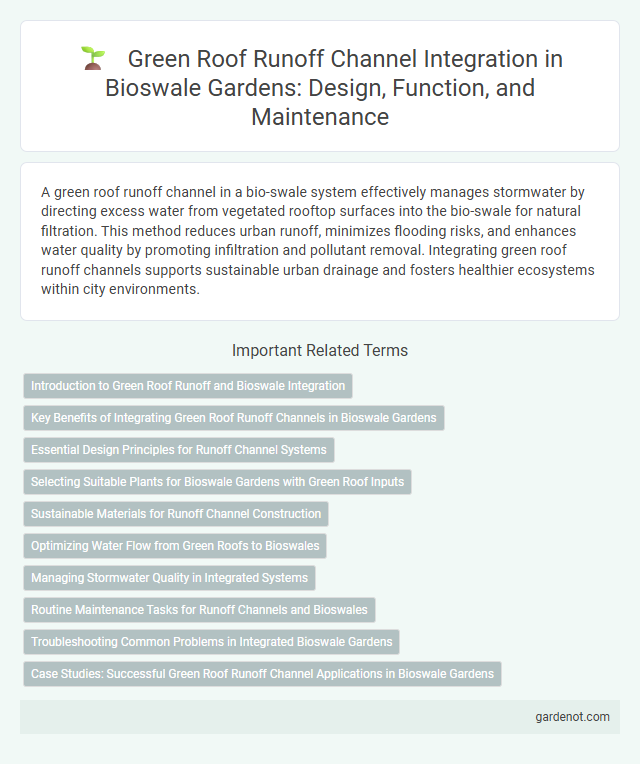A green roof runoff channel in a bio-swale system effectively manages stormwater by directing excess water from vegetated rooftop surfaces into the bio-swale for natural filtration. This method reduces urban runoff, minimizes flooding risks, and enhances water quality by promoting infiltration and pollutant removal. Integrating green roof runoff channels supports sustainable urban drainage and fosters healthier ecosystems within city environments.
Introduction to Green Roof Runoff and Bioswale Integration
Green roof runoff channels manage stormwater by directing excess rainwater from vegetative roof surfaces into bioswales, which are engineered landscape elements designed for effective water infiltration and pollutant filtration. Integrating green roof runoff with bioswales enhances urban water management by reducing surface runoff volume and improving water quality through natural filtration processes. This synergy supports sustainable urban drainage systems by mitigating flood risks and promoting groundwater recharge.
Key Benefits of Integrating Green Roof Runoff Channels in Bioswale Gardens
Integrating green roof runoff channels in bioswale gardens enhances stormwater management by efficiently directing excess water to permeable soil zones, reducing urban flooding risks. These channels improve water quality by filtering pollutants through vegetation and soil layers before infiltration, supporting healthier ecosystems. The system also promotes sustainable urban cooling and biodiversity, contributing to environmental resilience and energy savings.
Essential Design Principles for Runoff Channel Systems
Green roof runoff channel systems must prioritize permeability and gradient control to efficiently manage stormwater and reduce surface runoff, enhancing bio-swale functionality. Incorporating vegetation-transition zones within channels supports natural filtration and sediment capture, promoting water quality improvement. Utilizing durable materials with modular design ensures easy maintenance and adaptability to varying rainfall intensities and roof configurations.
Selecting Suitable Plants for Bioswale Gardens with Green Roof Inputs
Selecting suitable plants for bioswale gardens receiving green roof runoff involves prioritizing species adapted to fluctuating moisture levels and nutrient-rich water. Native grasses, sedges, and drought-tolerant perennials like Carex, Juncus, and Echinacea efficiently filter pollutants and support stormwater management. These plants enhance bioswale functionality by stabilizing soil, improving infiltration, and promoting biodiversity in urban green infrastructure.
Sustainable Materials for Runoff Channel Construction
Sustainable materials for green roof runoff channel construction include recycled plastic composites, permeable concrete, and sustainably harvested timber, which reduce environmental impact while enhancing durability. These materials improve water filtration and minimize pollutant discharge, promoting eco-friendly stormwater management in bio-swales. Incorporating lightweight, corrosion-resistant components also ensures long-term structural integrity under variable weather conditions.
Optimizing Water Flow from Green Roofs to Bioswales
Optimizing water flow from green roofs to bioswales enhances stormwater management by reducing runoff volume and improving water quality. Incorporating strategically designed runoff channels with permeable materials directs excess water efficiently from vegetated roof surfaces to bioswale inlets, promoting groundwater recharge. This integration minimizes erosion risks and supports the bioswale's native plant systems in filtering pollutants and managing peak storm flows.
Managing Stormwater Quality in Integrated Systems
Green roof runoff channels play a crucial role in managing stormwater quality within integrated bio-swale systems by directing excess water through vegetated pathways that filter pollutants and reduce peak flow rates. These channels enhance the bio-swale's capacity to attenuate contaminants such as heavy metals, nutrients, and sediments before stormwater reaches natural water bodies. Effective design of green roof runoff channels ensures optimal infiltration, promotes microbial activity, and supports sustainable urban drainage systems (SUDS) to mitigate flooding and improve water quality.
Routine Maintenance Tasks for Runoff Channels and Bioswales
Routine maintenance tasks for green roof runoff channels and bioswales include regular inspection for debris accumulation and sediment buildup to prevent clogs and ensure optimal water flow. Vegetation management involves trimming overgrown plants and replacing dead or diseased species to maintain healthy, functional bio-filtration. Periodic removal of sediment and organic matter preserves the structural integrity and hydraulic efficiency of the runoff channels and bioswales, promoting effective stormwater management.
Troubleshooting Common Problems in Integrated Bioswale Gardens
Green roof runoff channels in integrated bioswale gardens often face clogging issues caused by debris accumulation and sediment buildup, which reduce water flow efficiency. Regular inspection and removal of blockages ensure optimal drainage and prevent overflow that can damage plant life and soil structure. Implementing permeable grates and sediment traps enhances filtration, minimizing maintenance needs and promoting sustainable stormwater management.
Case Studies: Successful Green Roof Runoff Channel Applications in Bioswale Gardens
Case studies demonstrate that green roof runoff channels effectively direct stormwater into bioswale gardens, reducing urban flooding and improving water quality. Projects in Seattle and Portland reported a 40% decrease in runoff volume by integrating vegetated channels with bioswales. These applications support nutrient filtration, enhance groundwater recharge, and promote sustainable urban water management.
Green roof runoff channel Infographic

 gardenot.com
gardenot.com